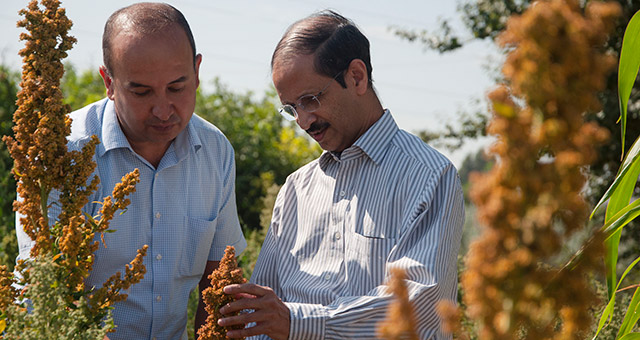
Climate change is widely believed to increase desertification globally. This process will have serious implications worldwide for social and economic stability, biodiversity and sustainable development. But drylands, in particular arid and semi-arid areas, home to some 2bn people, are considered to be most vulnerable. As they become ever more degraded, the impact on people and the environment can be very big.
Central Asia is facing the challenges of land degradation as large swathes of land are classified vulnerable drylands. By some estimates, over 70 per cent of the region are arid and semi-arid lands. Salinity, waterlogging, decreasing productivity of rangelands and reduction of soil productivity are a major concern and primary causes of desertification in the region. And as water gets scarcer, risks are growing. Livelihoods of pastoral and other communities are at stake as poor quality of soil and lack of water cause shortages of forage.
Researchers point to the need for diversification of production systems to tackle these problems. In marginal lands with different levels of water and soil salinity, it is more practical to use alternative salt- and drought-tolerant crops to replace or alternate with traditional crops, which are difficult or impossible to grow in such conditions. For example, salt-tolerant species like sorghum (Sorghum bicolor) and pearl millet (Pennisetum glaucum) need little water and are also highly resistant to drought and heat. They can also help to deal with two problems at once. First, a stable grain production and fodder supply can be set up. Second, their cultivation will help to prevent erosion and improve soil productivity. These features make sorghum and pearl millet especially suitable for saline and drought-prone areas.
In recent years, however, another plant has also received attention as a multi-purpose agro-industrial crop that can thrive in extreme soil and climatic conditions: quinoa (Chenopodium quinoa Willd.). Its ability to adapt to weather variations and its efficient use of water make quinoa an excellent alternative in the face of emerging challenges to food production in Central Asia.
Quinoa is a halophyte with the most tolerant cultivars being able to cope with salinity levels as high as those of sea water. Quinoa can grow successfully in poor soils, including pure sand and in environments with annual rainfall as little as 200 mm.
It is also well adapted to frost and can tolerate water deficit conditions. Quinoa is also one of the most nutritious food crops currently known. In addition to being gluten-free, the grain has exceptionally high protein content (11-18%) and a well-balanced amino acid composition.
Besides human consumption, quinoa seed has other uses as livestock and poultry feed. The whole plant can be used as green fodder and harvest residues as feed for animals.
This rationale is behind a new project called 'Cross-Regional Partnerships For Improving Food And Nutritional Security In Marginal Environments Of Central Asia'. The project, coordinated by ICBA and financially supported by the Islamic Development Bank, was launched at an inception workshop in Tashkent, Uzbekistan, in April 2015. Around 30 participants from Kyrgyzstan, Tajikistan and Uzbekistan, the International Center for Biosaline Agriculture (ICBA) and the International Center for Agricultural Research in the Dry Areas (ICARDA) attended the meeting.
The overall goal of the project is to improve food and nutrition security of low-income populations living in marginal areas of Central Asia through the introduction of environmentally resilient and nutritionally rich quinoa. The targeted countries are Kyrgyzstan, Tajikistan and Uzbekistan.
As a result of this project, it is expected that most promising quinoa germplasm accessions will be assembled, multiplied and transferred from the Andean region to the three countries; quinoa cultivars with tolerance to abiotic stress (salinity, drought and waterlogging) will be identified through farmer-participatory evaluation under marginal-environment conditions; integrated crop management practices will be developed for grain and forage production in the targeted countries; and capacity of partners and farmers in quinoa production and use will be enhanced.
Under this project, a training seminar was held in Tashkent, Uzbekistan, on 30-31 July 2015. Some 30 scientists and farmers took part in the seminar to discuss the benefits of introducing quinoa to Central Asia and how to better implement the project in the region. Participants also visited one of Tashkent State Agrarian University's experimental stations where quinoa is cultivated. They observed promising growth patterns of some of the varieties grown.
It is hoped that adoption of quinoa by a sizeable number of farms in marginal areas will eventually contribute to improved food, feed and nutrition security in the targeted countries. And resource-poor smallholder communities will have more food for themselves and feed for livestock. What is more, community-based seed enterprises and small machinery manufacturers will also benefit from producing seeds on demand and agricultural tools, respectively.